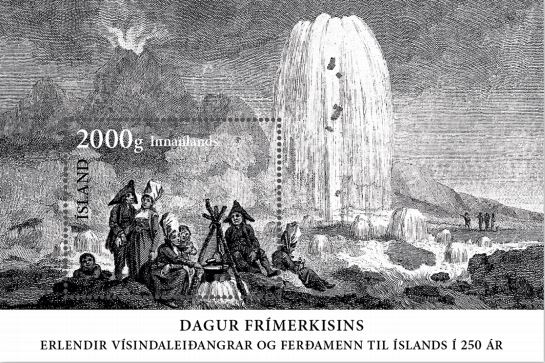Today, Iceland is one of the number one travel destinations in Europe – every year since the eruption of Eyjafjallajökull, the number of tourists has been increasing steadily – especially the past three years.
However, one could say that “tourism” in the sense of foreigners traveling to Iceland, whether on visits for leisure or on expeditions with a scientific objective, really started from the 18th century.
In January 1767, a French naval officer, Yves Joseph de Kerguelen de Trémarec, received instructions from Louis XV ordering him to sail to Iceland to assess the needs of French fishermen who were then stationed in Icelandic waters and assist them in matters of health and welfare. The vessel used for this expedition was the frigate La Folle („The Surprising“) with a crew of 200 men. A year later, Kerguelen returned to Iceland on the corvette L’Hirondelle (“The Swallow”).
He gave an account of his research and discoveries during the two journeys to Iceland in a book published in 1771 under the name “Relation d’un voyage dans la mer du Nord” (Account of a journey on the North Sea).
Kerguelen’s reports were important both militarily and scientifically, and because he had no personal financial or political interest in his missions, his writings are considered a reliable source of information.
Among other distinguished scientists who came to Iceland and wrote about the country were Sir John Stanley, Sir George Stewart McKenzie, William Jackson Hooker and Ebenezer Henderson.

654A – Day of the Stamp. Iceland opens to the world: 250 years of foreign expeditions and traveling to Iceland
654A Day of the Stamp.
Minisheet with 1 stamp. 2000g domestic (630 ISK)
Date of issue : 14.09.2017
The stamp will be issued for our Autumn issue on September 14th.
The eruption stamps are still available for sale on our website here or you can order them directly at stamps@stamps.is or by phone at : 00354-580-1050 from 9am-4pm Icelandic time

 Åland
Åland  Faroe Islands
Faroe Islands  Gibraltar
Gibraltar  Greenland
Greenland  Guernsey
Guernsey  Isle of Man
Isle of Man  Jersey
Jersey  Liechtenstein
Liechtenstein  Luxembourg
Luxembourg  Malta
Malta  Monaco
Monaco  Vatican City
Vatican City 
